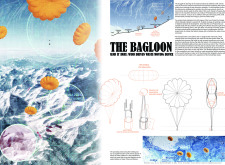5 key facts about this project
The project focused on managing waste for trekkers on Mt. Everest presents a practical solution to an environmental challenge that has grown with the increasing number of visitors to the mountain. It aims to alleviate the issue of human waste disposal, utilizing a balloon-based system to transport waste away from the site. This design blends modern technology with ecological responsibility, addressing the need for sustainable practices in a delicate environment.
Design Concept
At the heart of the project is the idea of using the natural winds on Mt. Everest to assist with waste removal. By looking at concepts used in the Loon Project by Google, the design transforms balloon technology from a communication tool into a method for managing waste. The goal is to avoid leaving waste behind on the mountain, thereby protecting the environment through a more effective waste disposal system.
Components and Materials
The project consists of three main elements: a waste vessel designed to hold human waste securely, an umbrella keel structure for stability and support, and a small navigation box with electronic devices for tracking and deployment. Each element is designed thoughtfully to function well at high altitudes, ensuring efficiency and reliability throughout the trek.
Deployment and Functionality
Trekkers will deploy the balloons when they produce waste, keeping them nearby during their journey. After completing the trek, the balloons will rise into the stratosphere, using the natural winds to carry waste to processing facilities in Nepal, China, and Bhutan. This approach effectively uses the environment to solve the problem of waste management.
The design features components that are foldable and easy to dismantle, making them portable for a team of four. This aspect addresses the practical concerns of carrying equipment in high-altitude conditions where weight and space are limited.
The project highlights a blend of advanced navigation systems and practical solutions for waste management, resulting in a method that helps preserve the environment of Mt. Everest. As the balloons ascend, they carry not only waste but also a focus on protecting the natural landscape.




















































